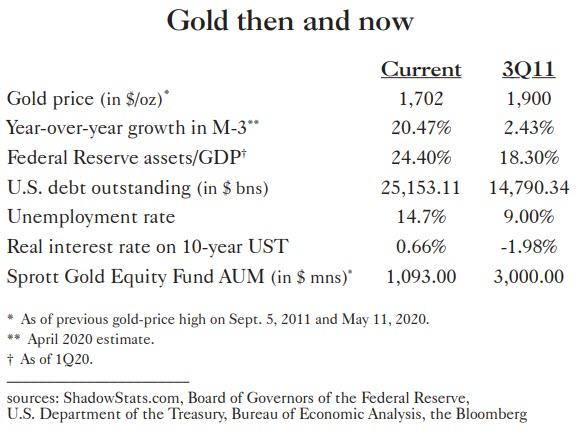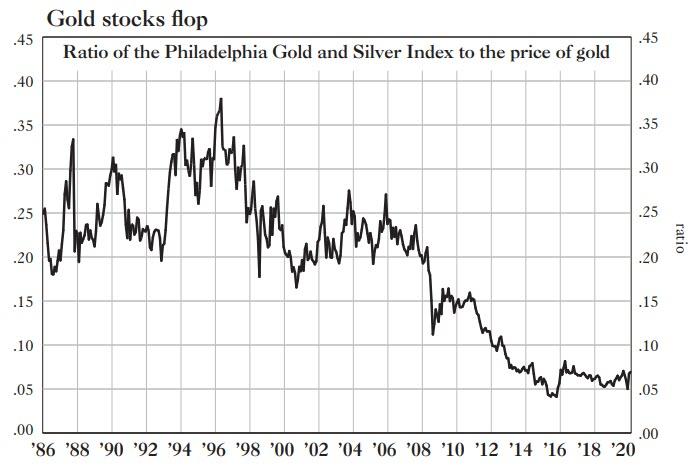"This Is The Perfect Environment For Gold To Take Center-Stage" Tyler Durden Tue, 06/02/2020 - 03:30
Excerpted from Grant's Interest Rate Observer (via Sprott.com),
Changing Monetary Places
The price of gold peaked at $1,900 an ounce in September 2011. Nine years and many radical monetary-policy experiments later, it trades at $1,702. That it ought to move higher, and will move higher, is the theme of this analysis.
If we’re repeating ourselves, it’s in the noble cause of protecting the wealth of the readers of Grant’s. The sheer brute force of pandemic public policy is tilting the balance of financial risk. History can’t exactly predict the outcome of the Federal Reserve’s unprecedented jag of money creation (never mind the humane reasons why those dollars were set afloat). But as to the perishability of paper money, the record is unarguable.
“[T]he French people,” pronounced the Bank for International Settlements in 1949, four years after the end of World War II, “remembering the old gold franc introduced by Napoleon in 1803 (the so-called franc germinal), which maintained its value intact up to 1914, and thus withstood the strain of two lost wars—1814 and 1871—as well as a number of other vicissitudes, cannot help thinking that, compared with the paper franc which since 1914 has lost 99% of its purchasing power, gold, irrespective of any short-term fluctuations in the price paid for it, is in the long run a trustworthy basis for savings.”
Even so, it’s not gold but bonds that investors crave.
They are grateful to purchase, for instance, the brand new triple-B-plus-rated PayPal 3¼s of 2050. How will the online money-transfer pioneer fare in the next 30 years? Could it be disrupted? What will become of the dollar, and interest rates, along the way? Is today’s buyer being compensated for these risks? Good questions, but, to yield-famished fiduciaries, not the most relevant ones. They need basis points, not monetary theory, and they draw confidence, rightly or wrongly, from the long-running decline of interest rates.
Gold may boast a multi-millennial record of honorable monetary service, but bond prices have been rallying for 39 years.
For all that gold is the epitome of money, and for all that Wall Street worships money, gold is unrespectable.
Mention it in most any institutional setting, and people wince, though perhaps we overanalyze. Asset managers want the prices of their assets to rise, and QE answers that need. The kind of money the beneficiaries of radical monetary policy want is the kind you mine on a keypad.
Yet now comes BofA Securities with a $3,000-per-ounce price target and persuasive supporting analysis under the very headline, “The Fed can’t print gold.” The seven authors—Michael Widmer leads the cast—make their case with the opening contention that gold is “the ultimate store of value.”
Amen to that, though you have to take the long view. In January 1980, the gold price briefly touched $850 an ounce. Nineteen years later, the same ounce fetched but $250. The dollar that you entrusted to the ultimate store of value had dwindled to 30 cents.
And if you had only bought a dollar’s worth of the S&P 500 instead, you’d have had $24.02. It was enough to turn the French peasantry to paper.
Gold promoters are therefore understandably more partial to the past 20 years than to the two decades preceding them. Since the peak of the dot-com stock market in early 2000, gold has handily outperformed equities and bonds alike.
It would be something to brag about if gold were an investment asset.
It is no such thing. Gold is a monetary asset (if the central banks didn’t think so, they wouldn’t be buying it). Under a gold standard, its value is fixed. Under no standard does it pay interest or retain earnings. Stocks and bonds are regenerative. Gold, being money, is as sterile as a dollar bill. Buying it, one incurs an opportunity cost in the shape of foregone interest, rent or dividends.
As money, gold competes with dollars. It likewise competes with credit, the promise to pay dollars. Thus, as the dollar strengthens, as real rates rise, so paper prospers. What sent gold into the investment wilderness in the 1980s and 1990s were high real rates, an improving U.S. government fiscal position and the oftrepeated incantation of Robert Rubin, Bill Clinton’s secretary of the Treasury, “A strong dollar is in the U.S. interest.”
Now that the length of the Treasury yield curve is pitched below the pre-lockdown inflation rate of 2%, the fiscal position is an even bigger shambles than it was before the bug bit. Black Sox–fashion, the government is trying to lose the monetary competition. If it wants it, gold is welcome to the title of the hardest and most value-retaining money under the sun. No central bank wants it...
* * *
In the final year of the 1929–32 bear market, the investor Bernard M. Baruch was buying gold rather than orphaned stocks and cast-off credit instruments. Long after the fact, Franklin D. Roosevelt’s Treasury secretary, Henry Morgenthau, Jr., asked him why. It was no innocent question, as the government had outlawed private gold holdings in 1933 and pre-1933 “hoarders” were still under a retrospective cloud. “[B]ecause I was commencing to have doubts about the currency,” the investor and elderstatesman-without-portfolio forthrightly replied.
Those doubts were surely well founded. Roosevelt did devalue the dollar, and he did commandeer the gold (paying the citizens $20.67 an ounce before marking it up to $35 an ounce), but reasoned doubts about the quality of the currency are perhaps as warranted today as they were in the final year of the Hoover administration. And the opportunity cost of owning a safe full of bullion is arguably lower today than it was even then.
Gold holders in 1932 passed up an average high-grade tax-exempt yield of 4.33%, more than double the one on offer today. In January 1932, the Dow Jones Industrial Average had fallen by 81% from its 1929 peak; within six months, the blue chips would hit bottom at 11% of the top index value. At this writing, the Dow has declined by 20% from its February 12 high and trades at 17.55 times trailing earnings (don’t ask about future ones). The Nasdaq is knocking on the door of a new high. “[S]ound investment securities are selling at prices lower perhaps than we shall see again,” Baruch observed in a January 1932 oped in the old New York Evening Post. Few would make that claim for today’s Fedsponsored opportunity set.
What makes the gold price go, according to the BofA analysts, is a conflation of real interest rates, the dollar exchange rate, volatility in the financial markets and commodity prices. We would add to that list a single word, “trust.” The greater the confidence in the words and deeds of the central bank, the weaker the gold price. Apropos of which, respondents to a Gallup poll conducted in the first two weeks of April said they had “a great deal” or a “fair amount” of confidence in Jay Powell to do right by the American economy. It was the highest such reading in 15 years.
We wonder what 1,000 random investors would tell Gallup if asked whether the Fed has abolished bear markets. To judge by the BofA’s conclusions as to speculative gold-positioning, replies would lean to the affirmative. Thus, Widmer et al. report, “momentum players” in gold futures “are currently holding 5.7% of their maximum allocations, well below the historical 99th percentile in history of 48%.”
As for gold-mining shares, John Hathaway, co-portfolio manager of the $1 billion-plus Sprott Gold Equity Fund, reports that interest is exactly nil. The Sprott bullion business is jumping, but not the mining-stock investment business. Blame previous poor performance, he says, or long memories of mine mismanagement around the time of the 2011 gold-price high, or the inherent risks of digging for a vanishingly scarce metal in inhospitable places. But for whatever set of reasons, he goes on, gold shares, in relation to bullion, are the cheapest they’ve been in his 20 years in the business: “What astonishes me—I’m an old value investor—is that so many companies are generating free cash flow, and it is not hard to find companies with free cash flow yields of 10% or better.”
There are finer judges of confidence in the stewards of paper money than this publication, which has had so little confidence, but we can read as well as the next person. And, in reading, we mark a new comment by Michael Arone, chief investment strategist of State Street’s American SPDR business.
“[G]overnment deficits funded by massive central bank balance sheets have distorted markets and the economy,” Arone says. “Also, the Fed’s failure to reduce monetary policy accom modation in better economic times has likely encouraged investors to take excessive risks, laying the groundwork for future asset price bubbles.”
Writing under the headline “Moral Hazard: Are Risky Bonds the New Treasurys?,” Arone concludes with a kind of resigned yes:
“The disconnect between an investment’s underlying fundamentals and its price makes investors uneasy. As a result of the Fed’s new programs, this tension is now most evident in the credit markets. Sadly, investors may have no choice but to dive in.”
Some do have a choice, though, and for those with the flexibility to choose we commend the words of Rick Rieder.
“[T]he monetary policy endgame may well be monetary debasement,” BlackRock, Inc.’s chief of global fixed income speculated in early September, months before the lockdown-induced monetary onslaught began.
“Under the gold standard this would not have been possible...but today money is created by printing presses, or even a few computer keystrokes.”
What to do? Seek protection in “equities, real estate and even hard assets that have historic value-relevance, such as gold.”
Perhaps the monetary seed that bloomed at BofA, and that has produced green intellectual shoots at State Street and BlackRock, holds the promise of a more open-minded investment establishment. Paul Singer, founder and president of Elliott Management Corp., a different, nonconforming kind of Wall Street establishmentarian, bangs the nail on the head in “Perspectives,” his new investment comment:
This is a perfect environment for gold to take center stage. Fanatical debasement of money by all of the world’s central banks, super-low interest rates and gold mine operation and extraction issues (to a large extent related to the pandemic) should create a fertile ground for this most basic of all money and stores of value to reach its fair value, which we believe is literally multiples of its current price. In recent months, gold has gone up in price to some degree, but we think that it is one of the most undervalued investable assets existing today...
[It] is the answer to the question: Is there an asset or asset class which is undervalued, underowned, would preserve its value in a severe inflation, and is not adversely affected by Covid-19 or the destruction of business value that is being caused by the virus?
If Singer is right (strength to his arm!), it won’t be because of any change in the nature of gold, but on account of a belated realization of the change in the quality of its competitors.
https://ift.tt/2BmrqMR
from ZeroHedge News https://ift.tt/2BmrqMR
via IFTTT






0 comments
Post a Comment